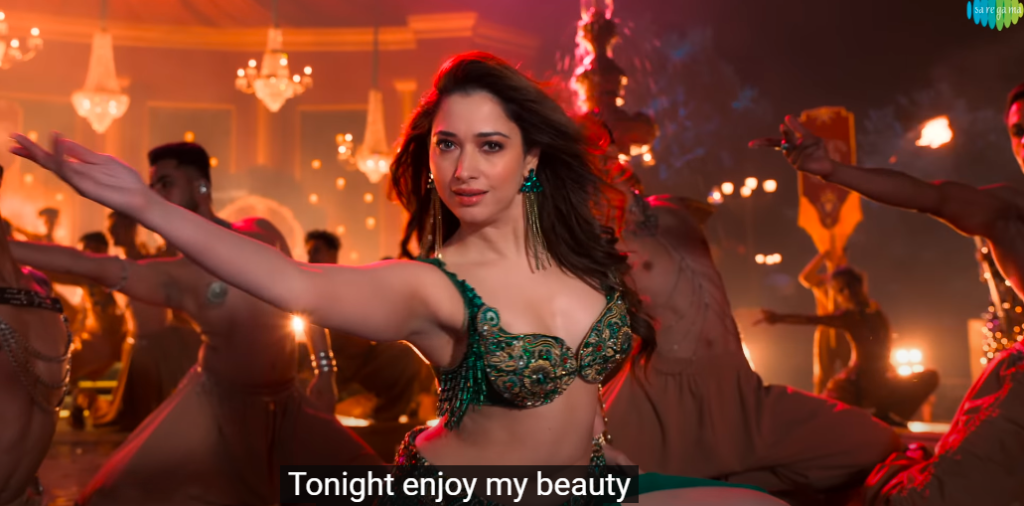Woman Dances to Song “Aaj Ki Raat” in Metro: A Viral Sensation That Sparked Controversy,In the time of online entertainment, it’s normal for snapshots of immediacy to become viral sensations. As of late, a video surfaced showing a lady moving richly to the melody “Aaj Ki Raat“ in a jam-packed metro train. While many found her exhibition engaging, it started a rush of blended responses internet, prompting a flood of savaging and analysis. This article dives into the occurrence, analyzing the setting of the dance, public responses, and the more extensive ramifications of web-based entertainment on private articulation.
The Video That Took Web-based Entertainment by Storm

The video, which immediately coursed across different stages, exhibits a lady clad in easygoing clothing moving cheerfully to the enthusiastic Bollywood number. Set against the background of a clamoring metro, the scene catches the embodiment of metropolitan life — where snapshots of delight and individual articulation frequently crash into cultural standards. The irresistible enthusiasm of the melody, joined with the lady’s uninhibited dance moves, immediately grabbed the eye of watchers. Woman Dances to Song “Aaj Ki Raat” in Metro: A Viral Sensation That Sparked Controversy.
The Unique situation: Why Dance in the Metro?
Public transportation is in many cases seen as an unremarkable part of metropolitan life, where people are submerged in their schedules. Be that as it may, unconstrained demonstrations of satisfaction can break this dreariness. The decision of “Aaj Ki Raat,” a famous track known for its exuberant musicality, adds a fascinating layer to the lady’s choice to move in such a setting. For the vast majority, her activities mirror a yearning for satisfaction and opportunity in a speedy world.
Public Responses: Love, Giggling, and Criticism
The video drew a wide exhibit of reactions, representing the different mentalities individuals have toward public showcases of warmth and articulation.
Positive Responses: Observing Spontaneity

Numerous watchers hailed the lady’s lighthearted soul. Remarks applauding her certainty and asking others to embrace their singularity overwhelmed virtual entertainment. Allies hailed her presentation as a reviving break from the standard, empowering self-articulation in any structure. Some even alluded to her as a “champion” for thinking for even a moment to move in broad daylight, a space frequently overwhelmed by similarity. Woman Dances to Song “Aaj Ki Raat” in Metro: A Viral Sensation That Sparked Controversy.
Savaging and Analysis: The Opposite Side of Fame
Notwithstanding the positive input, the video likewise pulled in a lot of savaging. Pundits scrutinized her choice to move in a public vehicle setting, marking it as unseemly or problematic. A few remarks wandered into a cruel area, with savages taunting her appearance and scrutinizing her expectations. This kickback features a distinct reality: while some celebrate individual articulation, others consider it to be a test to cultural standards.
Social Ramifications: The Dance Debate
This episode brings up significant issues about social mentalities toward public articulation. In numerous social orders, moving is frequently held for explicit settings — gatherings, weddings, or far-reaching developments. At the point when such demonstrations happen in regular spaces, they can summon blended sentiments.
Public Spaces and Individual Expression
The metro, as a public space, is intended for driving, not execution. Be that as it may, it can likewise be seen as a material for individual articulation. The lady’s dance difficulties the thought that public spaces ought to just be utilized for practical purposes. In a world progressively overwhelmed by computerized collaborations, minutes like these help us to remember the significance of human association and immediacy.

Cultural Standards versus Individual Freedom
The split between the individuals who support the lady’s activities and the people who condemn them reflects further cultural standards. Pundits frequently contend that public dignity ought to win, while allies advocate for the option to uninhibitedly articulate one’s thoughts. This discussion uncovers the strain between keeping social control and embracing individual inventiveness.
Virtual Entertainment’s Job: Intensifying Voices and Reactions
Virtual entertainment stages assume a critical part in molding popular assessment. They offer a space for both festival and analysis, permitting people to share their contemplations and sentiments progressively.
Viral Notoriety: A Twofold Edged Sword
The moment virality of the video highlights how rapidly satisfied can spread on the web. For the lady, her snapshot of euphoria changed into a subject of public discussion. While some might look for notoriety through open shows, the idea of web-based entertainment can frequently prompt startling kickback. The lady’s experience is a valid example — what started as a cheerful dance transformed into a perplexing conversation about cultural qualities.
Local area Building and Support
On the other side, virtual entertainment likewise encourages a feeling of local area. Allies of the lady mobilized behind her, making hashtags and having comparable accounts of happiness and articulation. This part of virtual entertainment features its true capacity as an instrument for strengthening, interfacing similar people and advancing a culture of acknowledgment.

End: Embracing Euphoria In the midst of Criticism
The episode including the lady moving to “Aaj Ki Raat” in the metro fills in as a microcosm of contemporary society. It mirrors the continuous strain between individual articulation and cultural standards. While her exhibition collected both commendation and analysis, it at last ignited a crucial discussion about the idea of public spaces and individual flexibility.
As we explore this computerized age, embracing snapshots of delight and suddenness, even in the midst of criticism is fundamental. The lady’s dance advises us that life is momentary, and finding satisfaction in surprising spots is something to be praised. In a world frequently obfuscated by routine and assumptions, maybe we could all follow her and dance somewhat more uninhibitedly — regardless of where we are.



